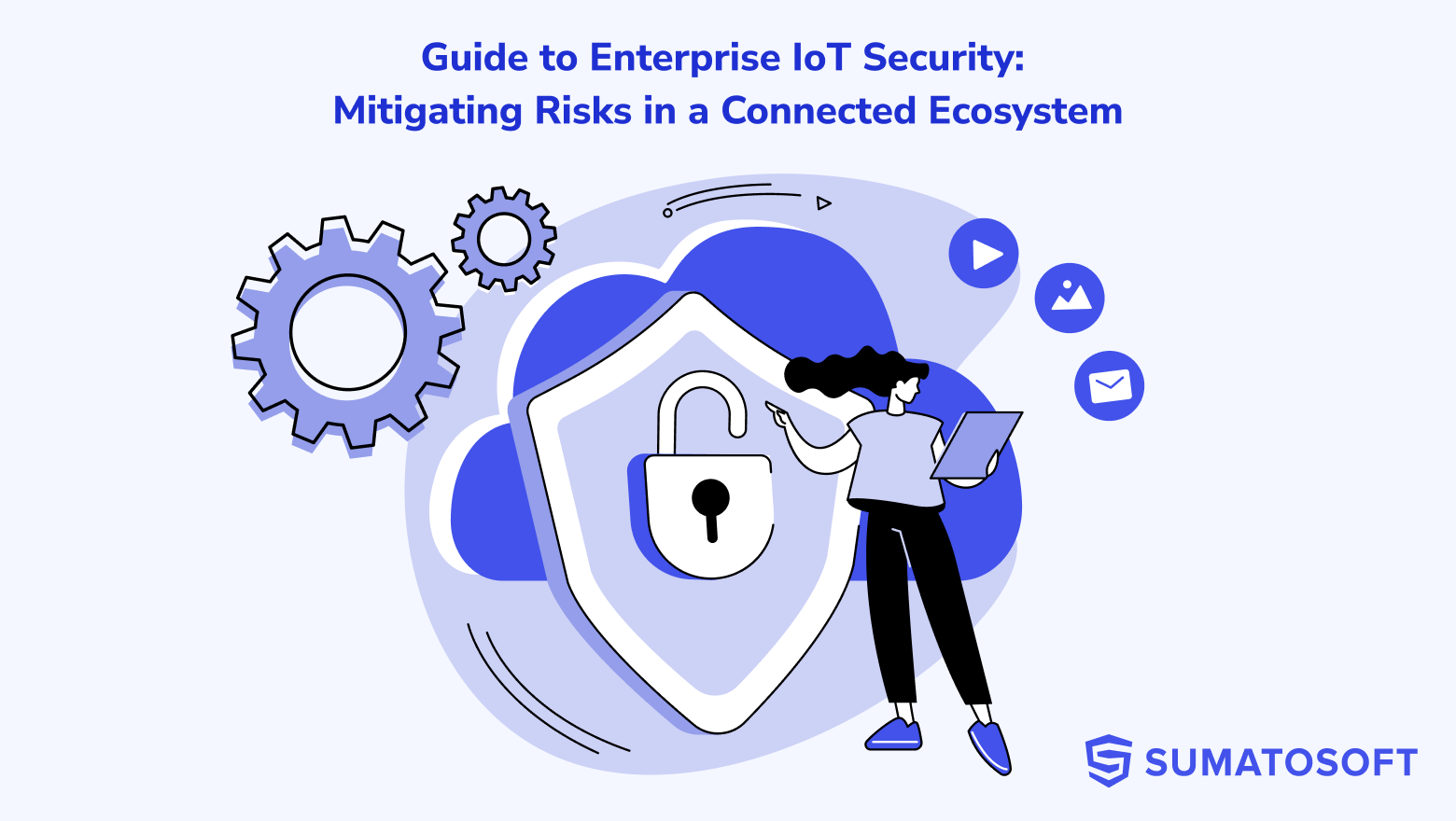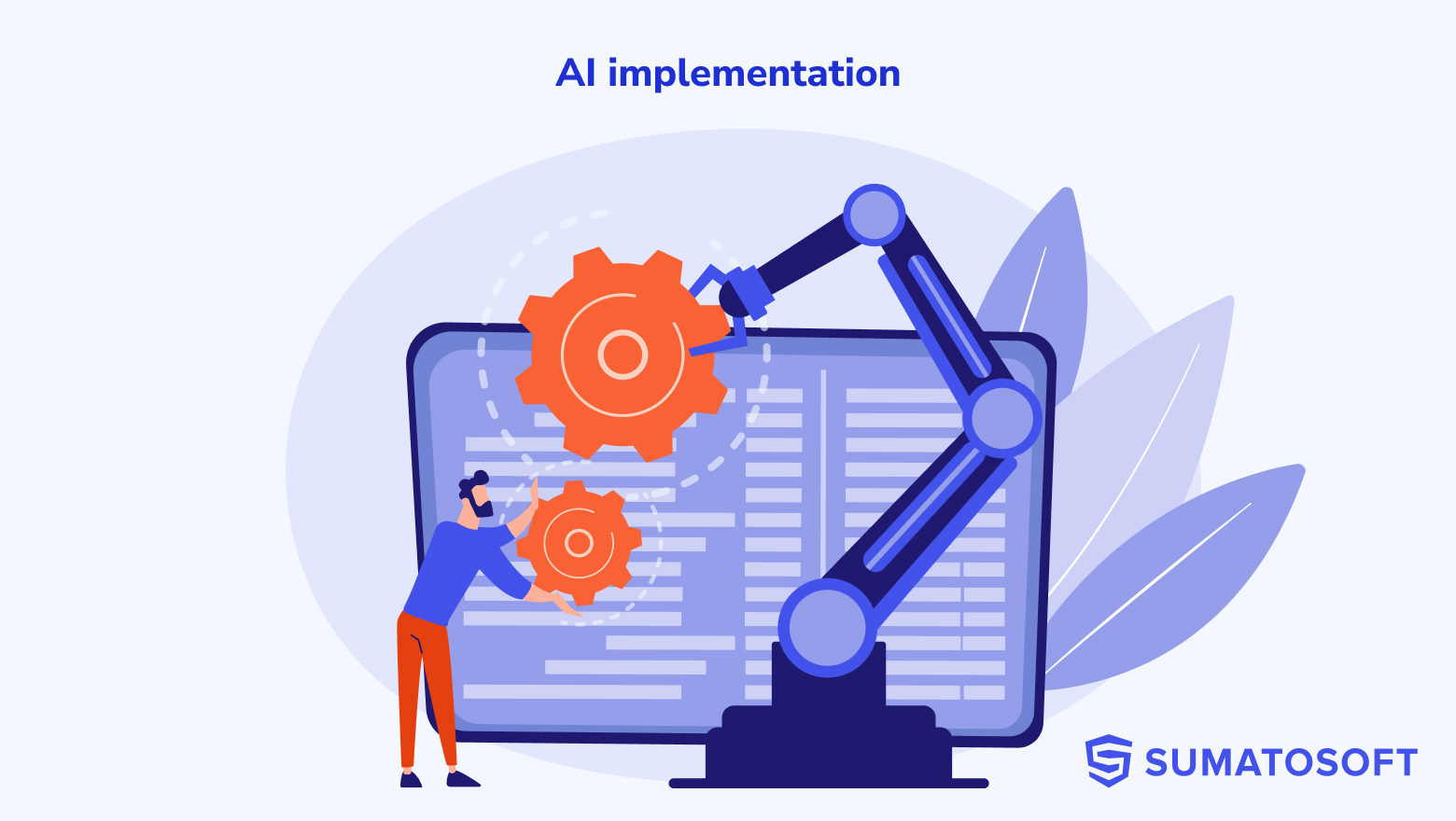How to: Business Process Analysis – Methods & Tools


We live in the era of globalization, huge international corporations, and remote work culture. In that constantly changing world business owners may wonder:
- How do businesses expand and mature?
- How do small companies transform into corporations?
- How do international companies successfully deliver services and products all over the globe?
- How do multinational businesses manage employees from different countries?
As an international company, we at SumatoSoft have found one answer to these questions – it’s impossible to become a huge international corporation and operate all over the globe without properly set and transparent processes.
To build such processes companies rely on business process analysis that helps to make incremental changes in the processes and improve them every time the analysis is performed. In the article, we gathered theoretical information about business process analysis and our expertise on how to do it right. We are sure it will be helpful for you.
Enjoy reading!
Everything You Should Know About Business Process Analysis

The chapter covers 5 issues:
- What is Business Process Analysis
- Business process analysis and Business analysis – the difference
- Benefits business process analysis brings
- How to choose the process for analysis
- Key business processes
What is Business Process Analysis
All businesses have some processes like maintaining the documents for each recruitment. Simply put, business process analysis (BPA) is the deep examination of the process, its participants, and external factors that have an impact on the process. In conducting business process analysis businesses want to see their process more effective. The second reason is to check whether the process is perfect, although this case is very unrealistic.
Business Process Analysis and Business Analysis – 2 Key Differences
Business analysis is the disciplined approach for identifying business needs and determining solutions to business challenges.
There are two key differences between business process analysis (BPA) and business analysis (BA).
The first key difference is the focus. Business process analysis is focused on a single process. Business analysis is focused on the business and all processes of the business.
The second key difference is the scale. BPA includes the analysis of the process itself, its participants, data within it, experts’ responsibilities, and separate operations in the process. BA is applied to a wider operation landscape, such as financial analysis, cost analysis, examination of the organization infrastructure, environmental analysis, market opportunities, product, execution plan, and much more.
Benefits of Business Process Analysis
- Documented processes
During the growth, businesses experience an increase in paperwork. Business process analysis helps to make a thorough review of processes, document processes that are based on handshake agreements, and get rid of irrelevant paperwork.
- A clear unified vision of processes for all participants
Documented processes foster a common understanding of actors and responsibilities among all process participants. That leads to a more friendly and stable environment among the workers.
- Optimized production
Optimized production means that a production process operates at its maximum capacity. In other words, the process is efficient. Efficiency implies avoiding the waste of materials, energy, efforts, money, and time in production. Business process analysis allows for identifying resource leaks and removing them.
- Smooth product/service delivery
Product or service delivery is the point of contact between clients and businesses, so it shall be as smooth and efficient as possible. BPA helps to reveal issues and pressure points during the delivery.
- Locate choke points
If a business works inefficiently because of systematic delays in delivery, it should run BPA and identify bottlenecks and areas that cause the delay. It may be a lack of resources at some stage, wrong order of actions, an inefficient element, or long waiting for a response from a third-party provider.
- The increase in the profit
More efficient processes mean that businesses either get more products for the same cost or pay less for the production of the same volume of goods and services. Both cases result in higher profitability of the business.
- Business owners get more future opportunities
Once the business is systemized, plenty of variants for the future of business become open: to grow it, step away from, sell, or franchise. It will be much harder or less profitable to do anything of it if the processes are vague, unorganized, undocumented, and based on handshake agreements.
- Decrease the redundant manual labor
The average weekly number of hours managers do manual tasks is 8 hours. Although not all manual operations can be eliminated, BPA helps to identify repetitive tasks and make templates for them. Moreover, businesses can get out of most manual data entering by automatically filling in the fields with the existing information from the database.
- Automation opportunity
Automation opportunity is an excellent benefit that BPA can bring. The first step toward automation is the analysis of the processes. A great example of the processes that were influenced by automation is the broad implementation of voice and chatbots in customer support and customer services.

How to Choose the Process For Analysis
Companies with a big number of employees and offices around the world have numerous business processes. Even small companies can count dozens of processes with only 10-20 employees on board. Here the question comes: how to pick exactly one process to analyze? You likely don’t want to spend several thousands of dollars and hundreds of hours of your life to hold an analysis that makes the process of coffee making ideal in your company.
So, how to pick the right process for analysis?
The answer is simple: pick one process from the list of key business processes.
What Are the 5 Core Business Processes
There are 5 main processes for small businesses (with less than 100 employees), while these 5 processes are split into separate processes for medium and big businesses. That happens because of the widening and deepening of every core process which leads to the necessity to split them into smaller sub-processes to simplify the process management and analysis. The core business processes and their sub-processes are:
1. Product Development
a) Quality improvement
b) Product development
2. Sales & Marketing
a) Sales process
b) Marketing strategy
3. Product/Service Delivery
a) Responsibility management
b) Product/Service delivery
4. Accounting & Technology
a) Accounting management
b) Technology Leveraging
5. Management, HR, Finance
a) Employee hiring and onboarding
b) Financial management
c) Strategic management
Look from the top down the list and consider every process from the perspective of your business. Do you see any issues in them or do you have doubts about whether it works well? If the answer is “yes”, it’s business process analysis time.
Process Analysis Methodology [5 Core Steps]
Steps to process business analysis are not a secret. If we decompose the most complicated process analysis approach into its main steps we get the next scheme:
BPA starts with organizing a team and defining the scope of work and key deliverables, the team members explore the processes and describe them and use special techniques to analyze the gathered data and find answers to the most sensitive questions. After describing and analyzing the current state of affairs, the team develops an improvement plan and implements it.
Thus, we get 5 common steps of BPA:
1. Organizing a team and defining the scope of work
2. Exploration of the processes and describing them
3. Process analysis
4. Development of an AS IS and TO BE processes
5. TO-BE process implementation
We also wish to emphasize additional meaningful terms we use in our simplified scheme:
- Key deliverables
- Special techniques for process analysis
- Sensitive questions about the processes
They also will be examined in the article below. But first, let’s describe the steps of business process analysis. We will be concise and concrete in the presentation of the information.
Step #1: Organizing a Team and Defining the Scope of Work
Everything starts with a team since team members are stakeholders in the analysis process. The number of roles in the team can vary depending on many factors, but usually, its number doesn’t exceed 4.
They are:
- Project sponsor – most often this is a business owner or an employee responsible for the effective operation of a business unit or a whole business. The project sponsor initiates the business process analysis, allocates resources, and approves the scope of work and key deliverables.
- Project manager – who is responsible for the organization of the analysis process. Project managers also provide constant support to team members at all stages.
- Analyst – whose set of responsibilities includes: research of the process, information gathering, process analysis, documentation, and the development of recommendations for an improvement plan.
- Business domain experts – are employees involved in the business process flow. They can provide relevant knowledge, help an analyst in gathering information about the process, and provide feedback about the current state of affairs.
Then the team needs to constrain the scope of work. The scope of work comprises:
- processes for analysis
- third parties like customers, suppliers, intermediaries that are involved in the processes
- goals of BPA – the expected effects of analysis: you have an issue and want to find a solution for it or your delivery is always not in time.
- general KPIs and benchmarks so you will be able to evaluate whether you achieve the initial goal or not.
Key Deliverables
- a document with described team members and their roles;
- a document with a defined scope of work and metrics to measure the success of the analysis.
Pieces of Advice
- Target processes that have the highest business impact.
- The scope of work should not be too broad or vague. If there is any uncertainty on what goals and metrics should be set, split the big goal into several smaller ones.
Step #2: Define, Examine, Describe, Visualize the Process
Before the analysis starts it’s necessary to get a comprehensive view of the processes that exist in the business. There are three ways how analysts can hold research about the current process:
- Gather information by yourself from documents.
- Gather the information by observing the flow from the start to its end.
- Conduct interviews and ask for feedback from domain experts.
All information should be systematized and documented because it will become a deliverable of this step later. The business process must be defined in various terms like:
- the information that is used
- the sufficient and necessary information for the process to be finished successfully
- what triggers the start of the process
- the point at which the process is considered finished
- what the result of the process is
- resources that are utilized during the process
- information about experts’ activity: what they do, the frequency of the process, what software and instruments they use
Diagrams are very helpful here in describing the process and the roles of involved experts. Visualization is a great instrument to get a simplified compact view of the process regardless of its complexity.
The most valuable diagrams here are UML activity diagrams, flowcharts, BPMN diagrams, which can visually depict all aspects of a process.
Charts for Process Vizualization
Workflow
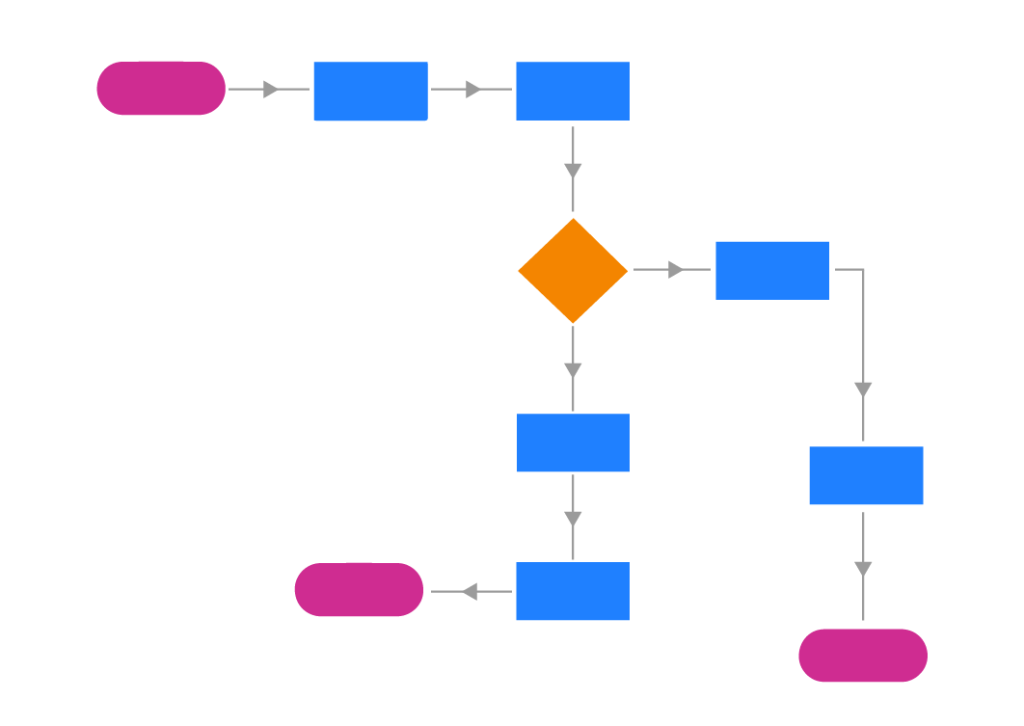
Flowcharts are graphical representations that outline a sequence of steps or activities in a process. They are commonly used for simplifying complex processes and are easily understandable by both technical and non-technical audiences. Various shapes like rectangles, diamonds, and arrows are used to denote different types of activities and the flow of the process.
Activity Diagram
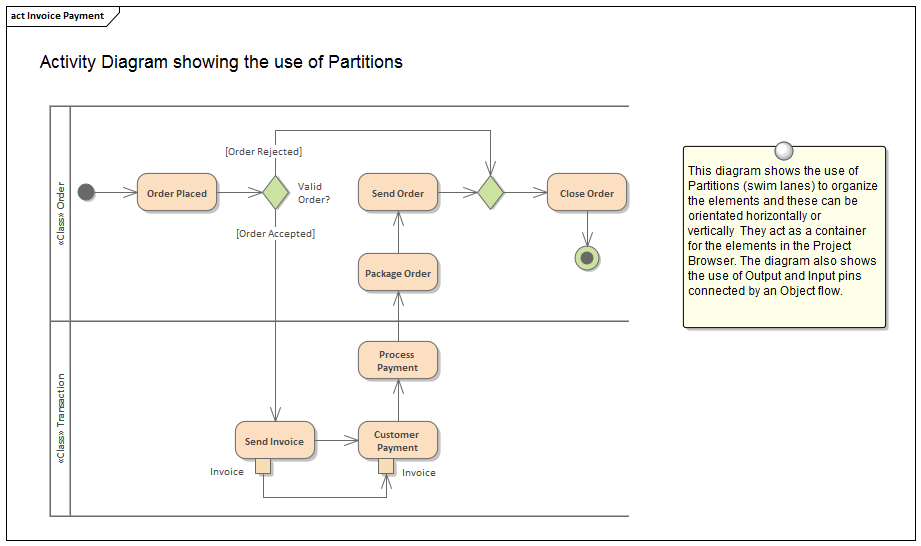
Activity Diagrams are a part of the Unified Modeling Language (UML) and are usually more detailed than flowcharts. They often employ swimlanes to indicate roles and responsibilities, synchronization bars for parallel processing, and can include multiple exit decision points. The activity diagram is not limited to software engineering and has been adapted for business process modeling as well.
Business Process Model and Notation (BPMN)
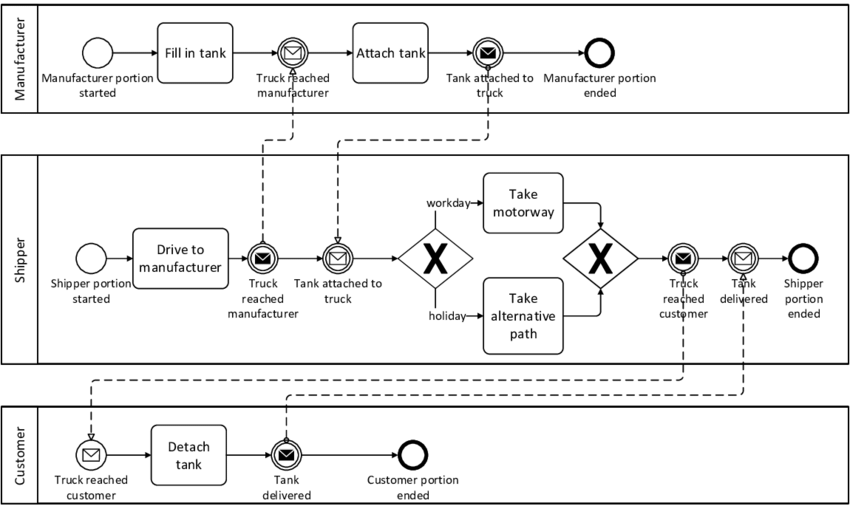
BPMN is a standardized graphical modeling language designed specifically for business process modeling. It is complex and versatile, allowing for detailed representations including collaborative and internal processes. Pools and swimlanes are commonly used in BPMN to segregate roles and responsibilities across different departments or organizations.
These diagrams serve different needs and levels of complexity in business process analysis, from the straightforward linear processes captured in flowcharts to the more complex, multi-role processes depicted in BPMN.
Key Deliverables:
- Detailed process description (it’s also called AS IS process)
- Process diagrams (workflow, BPMN, activity diagrams)
- Diagrams description
A Piece of Advice:
- Don’t observe every step of experts in the process directly. Direct control and observation may lead to unnecessary interference and extra stress on the experts resulting in wrong conclusions.
- You may ask a question to domain experts about what they would implement to improve the process.
Step #3: Process Analysis
Finally, analysis comes into play.
In that step, the analyst needs to identify challenging issues in the current process and opportunities to make it more effective.
There are 4 main specialized methods for analysis:
Business Process Analysis Methods
- Gap method– it compares the “gap” that compares the target performance metrics and the current ones. A gap is a potential improvement, while the solution for achieving it is still to be found.
- Value-added method – reveals the value every step in the process brings to the business. There are three categories of value: real value-added (RVA) – and value for customers. Business value-added – value for businesses. Non-value-added that don’t meet customer or business needs and presents no value, for example, regulatory obligations of preparing some reports, makins additional quality assurance activities, etc.
- Root cause method – is implemented when some issues need to be solved or when a project sponsor considers that the process results are poor. The root analysis is conducted by asking “why” questions at every step of the process, looking for the core issues that lead to poor outcomes.
- SIPOC analysis – this is a high-level overview that maps out the Suppliers, Inputs, Process, Outputs, and Customers involved in a process. It serves as a starting point for any process analysis by setting the boundaries and participants of the process. The SIPOC analysis helps to identify where in the larger ecosystem a gap or a non-value-added step might be occurring and who the responsible parties are.
Regardless of the method chosen, there are dozens of questions that should be answered in that step. We will mention some of them:
- Do you see steps that cause delays?
- Do you see the most time and cost consuming stages?
- Do domain experts have the necessary resources to perform their tasks effectively?
- Is there any redundant or noise information?
- What is the value of key performance indicators like average time for completion?
- Are there any best practices and standards implemented?
- Can work be shifted from paper to computer? Would it be effective?
Piece of advice:
- one more analysis method you can use is capturing the knowledge and expertise of longtime employees. Sometimes the domain experts can give answers to the core questions very fast, and their answers will be precise.
Step #4: Development of an AS IS – TO BE Processes
Upon completing the analysis, the focus shifts to transitioning from the current (“AS IS”) state of the process to the desired (“TO BE”) state. Here, the team collaborates to propose modifications to the existing process flow, adjustments in resource allocation, communication shifts, and transformations. The goal is to eliminate inefficiencies such as resource leaks and bottlenecks and align the data flows across stakeholders.
The business analyst documents these proposed changes, contrasting them with the initial ‘AS IS’ diagrams. These new ‘TO BE’ diagrams outline the planned improvements and offer a roadmap for the forthcoming implementation.
Key Deliverables:
- ‘AS IS’ and ‘TO BE’ Process Diagrams: Including workflow diagrams, activity diagrams, BPMN diagrams, and other relevant models that illustrate both the current state and the planned improvements.
- Change Matrix: A detailed table or document outlining the changes from ‘AS IS’ to ‘TO BE’, specifying what will be altered, added, or removed.
Piece of Advice:
- Aim for clarity and comprehensiveness in the ‘TO BE’ process descriptions to ensure easy understanding by domain experts.
- Process analysis and improvement is an ongoing task; don’t consider this a one-off project but rather an iterative exercise.
- Resist the urge to completely overhaul a process unless absolutely necessary; often, incremental changes to the existing process can yield significant improvements.
Step#5: TO-BE Process Implementation
Finally, when everything is ready, capture the value of key metrics at the moment and start improving a process through incremental changes. The team should control the implementation of their new instructions across different units and domain experts, and whether they get the desired results or not.
Two key questions that should be answered in that step are:
- Is the improved plan fully implemented?
- Do we achieve our goals by implementing altered processes?
Answers to these questions help to reveal to the team whether they move in the right direction and help to understand the value their actions and decisions bring to the business and clients.
Final Words From the SumatoSoft Team
Business Process Analysis is an action that may seem unnecessary, but it may help businesses to achieve new standards, produce better products, provide better services, and increase employee satisfaction.
Businesses definitely can exist and make a profit without business process analysis. However, companies that ignore the value of process analysis will probably disappear in the long-term period or experience difficulties during the expansion.
We know that for sure because we made business process analyses for ourselves and many other companies. Contact the SumatoSoft team to get a free consultation on business analysis!
Thanks for reading!
Let’s start
If you have any questions, email us info@sumatosoft.com

